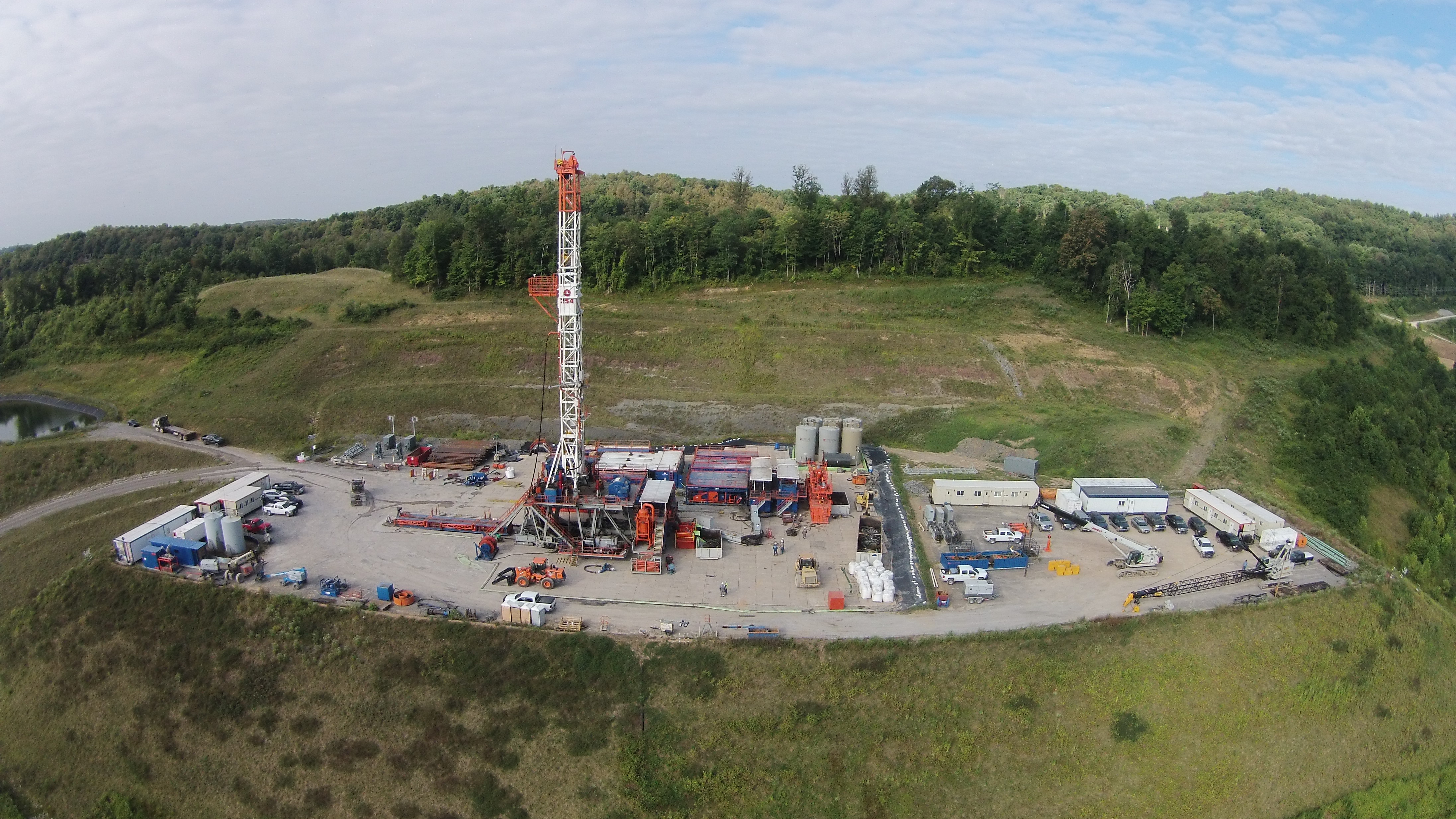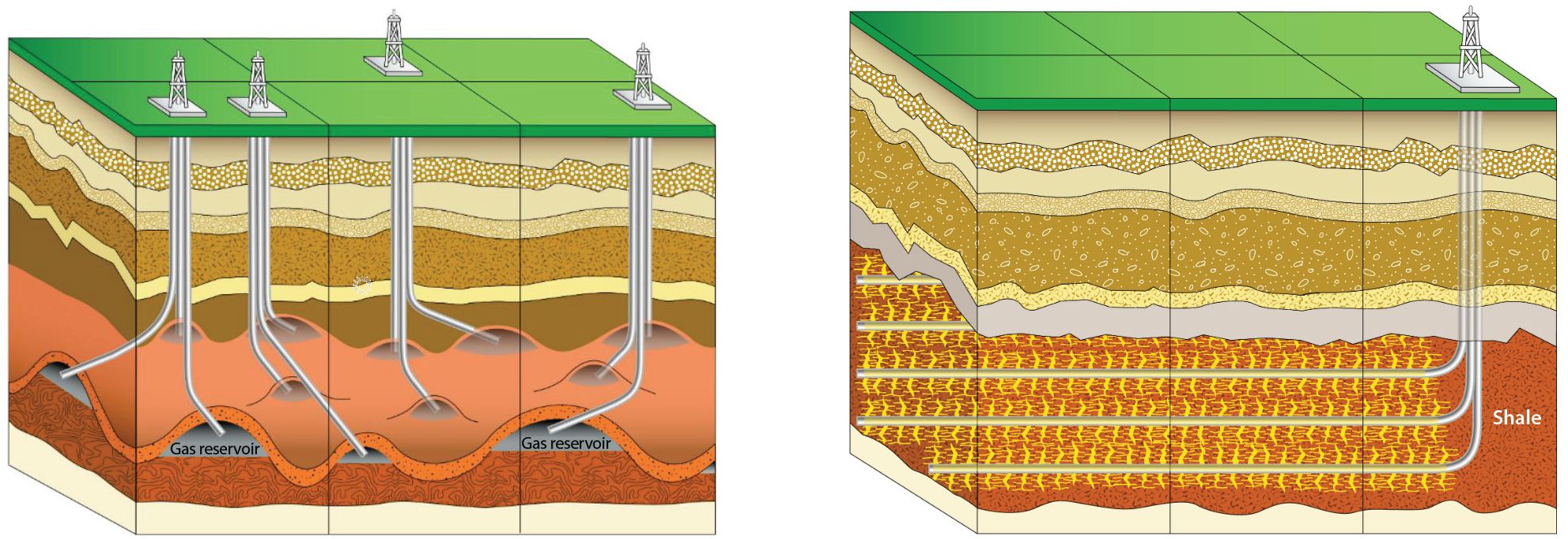How is land used? How do technologies and regulations minimize land use?
Introduction
All energy production requires land. Reducing the land-use “footprint” of the energy industry is an important part of limiting environmental impacts while meeting our energy needs. Advanced exploration technologies such as 3D seismic imaging, and drilling technologies such as horizontal and slanted wells, reduce the amount of land disturbed for a given amount of oil or gas produced.
Marcellus Shale Energy and Environment Laboratory drill site near Morgantown, West Virginia. Image credit: Photo courtesy of Northeast Natural Energy.
The Size of Well Sites
Drilling and hydraulically fracturing a well requires several acres around the well for the drilling rig, drill pipe storage, trailers for equipment and staff, pump trucks, data vans, and pits or tanks for water and waste storage. Once drilling is finished and the well is producing oil or gas, much of the drill site can be reclaimed. State and federal regulators require and oversee these reclamation efforts.1,2,3,4 The size of a well site, or “pad”, will depend on many factors, including location, land use restrictions, and the type and number of wells being drilled from the site. To take just one example, the total land footprint of a typical well site in Pennsylvania’s portion of the Marcellus Shale is five to eight acres – this includes the land taken up by water impoundments for hydraulic fracturing, access roads, and other equipment.5 For more information on how the land footprint of a well site may change over time, see “The Pinedale Gas Field, Wyoming” in this series.
Schematics showing how multiple wells can be drilled in different angles and directions from a single site, reducing land use. Left: directional drilling to reach multiple lens-like gas reservoirs. Right: horizontal drilling and hydraulic fracturing of shale. Image credit: Government Accountability Office.6
Advances in Drilling Technology: Fewer, Smaller Well Sites
Modern drilling technology allows a drill to be guided horizontally underground for up to several miles.7 This allows operators to avoid sensitive environments and drill multiple wells in different directions from a single site. As drilling technology continues to improve, longer horizontal wells will continue to reduce the number of sites needed.
Advances in Seismic Imaging: Fewer Unproductive Wells
Exploration for oil and gas requires a detailed image of the rocks below the Earth’s surface. Seismic imaging – like an ultrasound for the Earth – helps geoscientists to identify rock layers that are most likely to contain oil and gas, reducing the number of unproductive wells that are drilled. This in turn improves the land-use efficiency of oil and gas production. In the early 1970s, only 60% of wells drilled in the U.S. successfully hit an economically viable oil or gas deposit. By 2005, this had improved to 90%, due largely to improvements in 2-D and then 3-D seismic imaging, as well as other tools for monitoring and analysis.8 This improvement has been seen not only in newly explored areas but also in existing oilfields, where a more detailed image helps operators to drill new wells in the most productive parts of the field.
Changes in a Well’s Footprint Over Time
- The initial development of an oil- or gas-producing area involves acquiring seismic information and drilling wells to identify the total size of the oil or gas reservoir and define the areas likely to be most productive. This process largely uses single-well drilling sites with a high land-use footprint.
- Once this initial effort is completed, the relative land disturbance decreases as multiple wells are drilled from each site, unproductive areas are avoided, companies use centralized equipment and fluid handling facilities, and pipelines replace trucks for moving water, oil, and gas.
- Once a well starts producing oil and/or gas, the drilling equipment is removed and much of the site is remediated. Supporting infrastructure, such as tanks, pipelines, and access roads, remain in place as long as the well is active, which may be many decades. Automated data collection can reduce the number of trips needed and the resulting land disturbance.
- When a well is decommissioned, states require the operator to remove all surface equipment and plug the well with cement. State regulatory agencies maintain plugging records, which are commonly publicly available.9
- Unproductive wells may sit idle for years, and are sometimes abandoned without being adequately sealed, especially when companies go out of business. Improperly abandoned wells pose particular environmental risks – see “Abandoned Wells” in this series for more details.
Roads, Plants, and Pipelines
The land footprint of oil and gas extends far beyond the wells:
- New production areas require new access roads, pipelines, and other infrastructure.
- Natural gas must be purified and crude oil must be refined before they are used. As of 2014, there were over 550 gas processing plants10 and over 140 oil refineries11 in the United States.
- Processed/refined products must be distributed by truck, rail, pipeline, or boat. Each mode of transport has different impacts on land- and energy-use – see “Transportation of Oil, Gas, and Refined Products” in this series for more on this topic.
- Other land uses include facilities for the treatment and disposal of wastewater; natural gas power plants; and gasoline service stations.
The modern energy system is vast. In areas of intense production, land dedicated to oil and gas activity can be very high as a proportion of total land use. Overall, however, the high energy density of oil and gas results in relatively little land disturbance for a large amount of energy production.12 As the national and global energy sectors evolve over time, minimizing the land footprint of all energy technologies remains a key topic in attempts to balance energy production and environmental protection.
More Resources
Jones, N.F. et al. (2015). The Energy Footprint: How Oil, Natural Gas, and Wind Energy Affect Land for Biodiversity and the Flow of Ecosystem Services. BioScience, 65(3), 290-301.
References
1 State of California – § 1776. Well Site and Lease Restoration, California Statutes and Regulations for the Division of Oil, Gas, & Geothermal Resources, January 2018.
2 Kansas Office of Revisor of Statutes – Kansas Statutes Chapter 55: Oil and Gas, Article 1: Oil and Gas Wells; Regulatory Provisions, 55-177: Removal of structures and abutments from lands after abandoning wells; exception.
3 Commonwealth of Pennsylvania – The Pennsylvania Code: § 78.a.65. Site restoration.
4 Bureau of Land Management (2007). Chapter 6 – Reclamation and Abandonment. In: Surface Operating Standards and Guidelines for Oil and Gas, Fourth Edition – Revised 2007.
5 Penn State Public Broadcasting – Explore Shale: How much land in Pennsylvania has been affected by Marcellus Shale drilling? Based on data from FracTracker Alliance and the Pennsylvania Department of Environmental Protection.
6 U.S. Government Accountability Office (2014). Updated Guidance, Increased Coordination, and Comprehensive Data Could Improve BLM’s Management and Oversight.
7 “Halliburton, Eclipse Resources complete longest lateral well in U.S.” World Oil Magazine, May 31, 2016.
8 Cochener, J. (2010). Quantifying Drilling Efficiency. Working Paper, U.S. Energy Information Administration.
9 Railroad Commission of Texas – Oil and Gas Well Records.
10 U.S. Energy Information Administration – Natural Gas Annual Respondent Query System (EIA-757 Data through 2014): 757 Processing Capacity.
11 U.S. Energy Information Administration – Number and Capacity of Petroleum Refineries.
12 McDonald, R.I. et al. (2009). Energy Sprawl or Energy Efficiency: Climate Policy Impacts on Natural Habitat for the United States of America. PLoS ONE 4(8): e6802.
Petroleum and the Environment
Download a full PDF of Petroleum and the Environment (free) or purchase a printed version ($19.99).
Other parts in this series:
1. Petroleum and the Environment: an Introduction
2. Water in the Oil and Gas Industry
3. Induced Seismicity from Oil and Gas Operations
4. Water Sources for Hydraulic Fracturing
5. Using Produced Water
6. Groundwater Protection in Oil and Gas Production
7. Abandoned Wells
8. What Determines the Location of a Well?
9. Land Use in the Oil and Gas Industry
10. The Pinedale Gas Field, Wyoming
11. Heavy Oil
12. Oil and Gas in the U.S. Arctic
13. Offshore Oil and Gas
14. Spills in Oil and Natural Gas Fields
15. Transportation of Oil, Gas, and Refined Products
16. Oil Refining and Gas Processing
17. Non-Fuel Products of Oil and Gas
18. Air Quality Impacts of Oil and Gas
19. Methane Emissions in the Oil and Gas Industry
20. Mitigating and Regulating Methane Emissions
21. Regulation of Oil and Gas Operations
22. Health and Safety in Oil and Gas Extraction
23. Subsurface Data in the Oil and Gas Industry
24. Geoscientists in Petroleum and the Environment
Glossary of Terms
References


